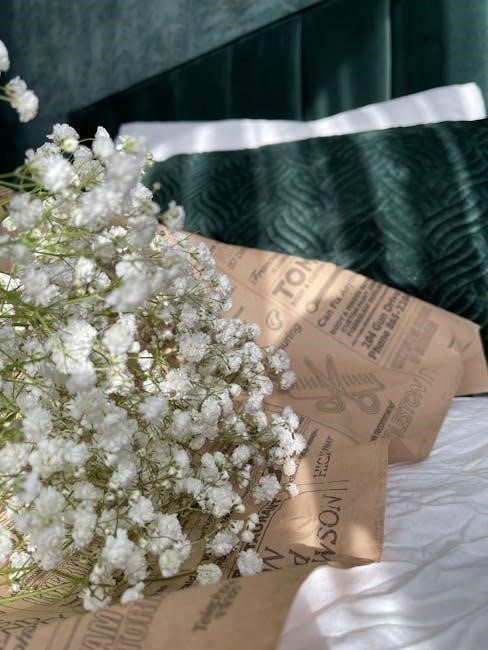Welcome to the enchanting world of Kawandi quilting‚ a vibrant craft rooted in the Siddi tradition of Western India. Discover its unique improvisational style‚ rich history‚ and meditative stitching process through these comprehensive tutorials‚ designed for both beginners and experienced quilters alike.
What is Kawandi Quilting?
Kawandi quilting is a vibrant textile art form rooted in the Siddi tradition of Western India‚ with African origins. It involves creating unique‚ hand-stitched quilts using fabric scraps‚ emphasizing improvisation and sustainability. The process typically starts from the outside edge‚ working inward‚ and incorporates techniques like running stitches and appliqué. Kawandi quilts are celebrated for their colorful‚ layered designs and cultural significance. This craft not only preserves heritage but also encourages creativity and resourcefulness‚ making it a cherished practice among quilters worldwide;
Why Kawandi Quilting is Unique
Kawandi quilting is unique due to its cultural blend of African and Indian influences‚ reflecting the Siddi community’s heritage. The process begins from the outside edge‚ working inward‚ which distinguishes it from traditional quilting methods. Utilizing fabric scraps‚ Kawandi quilts are both sustainable and one-of-a-kind. Hand-stitching adds a personal‚ meditative touch‚ emphasizing each stitch’s significance. The vibrant colors and improvisational techniques create dynamic‚ unique designs. This craft not only preserves cultural heritage but also fosters creativity and storytelling through fabric‚ making each quilt a testament to its maker’s skill and history.

Gathering Materials for Kawandi Quilting
Collect fabric scraps‚ needles‚ threads‚ and sharp scissors. Lightweight batting and a thimble are essential. Repurpose old saris‚ cotton prints‚ or denim for a sustainable‚ unique project.
Essential Tools for Kawandi Quilt Making
Sharp hand-sewing needles in sizes 8-12 are crucial for precise stitching. Use sturdy threads like quilting thread or embroidery floss to complement fabrics. Small‚ sharp scissors are vital for cutting fabric accurately. A thimble protects fingers during repetitive stitching. Pins and a seam ripper are optional but handy for securing fabrics and correcting mistakes. Lightweight batting‚ preferably cotton‚ adds texture and warmth. A ruler helps in measuring and planning designs. These tools enable creativity and precision‚ allowing you to craft unique‚ hand-stitched Kawandi quilts with ease and confidence.
Choosing the Right Fabrics and Batting
For Kawandi quilting‚ select fabrics that inspire creativity and reflect your personal style. Cotton prints‚ saris‚ and denim scraps work beautifully‚ as they offer vibrant colors and textures. Organize scraps by color and texture to simplify the design process. Lightweight cotton batting is ideal for its softness and drape‚ but feel free to experiment with other materials for unique textures. Consider the cultural inspiration of Siddi quilts‚ which often use diverse fabrics. Remember‚ Kawandi quilting thrives on improvisation‚ so embrace the freedom to mix patterns and hues. Your fabric choices and batting selections will bring your quilt to life‚ creating a meaningful and eco-friendly masterpiece.
Core Techniques of Kawandi Quilting
Kawandi quilting involves hand-stitching and an innovative outside-in construction. Learn to layer fabrics and batting‚ creating a unique‚ textured design. This technique emphasizes slow‚ meditative stitching and creativity.
Starting Your Kawandi Quilt: The Outside-In Method
Kawandi quilting begins with the outside-in method‚ a unique approach that sets it apart from traditional quilting. Start by selecting a central fabric piece or arranging smaller scraps to form the core. Fold the raw edges of your first border fabric under‚ creating a neat finish‚ and pin it to the center. Hand-stitch this border using a running or backstitch‚ ensuring even spacing. Gradually add more borders‚ folding and stitching each in place. This method allows for organic growth‚ embracing improvisation. As you layer fabrics and batting‚ the quilt evolves into a vibrant‚ textured design. The outside-in technique encourages creativity and flexibility‚ making it a meditative and rewarding process.
Adding Borders and Layering Batting
In Kawandi quilting‚ adding borders and layering batting is a key step that enhances the quilt’s texture and appearance. Select a border fabric strip‚ fold its raw edges under for a neat finish‚ and pin it to the edge of your central piece. Hand-stitch the border using a running or backstitch. Each subsequent border is added by overlapping the raw edges onto the previous one‚ folding and stitching in place. After completing several borders‚ layer batting over the back of the assembled fabric. Continue adding border pieces‚ carefully holding the batting in place. This methodical layering and stitching create a rich‚ textured quilt with a unique design.

Hand-Stitching in Kawandi Quilts
Hand-stitching is the heart of Kawandi quilting‚ offering a meditative process. It allows for creativity and precision‚ with decorative stitches bringing the quilt to life with a personal touch.
Mastering the Running Stitch and Backstitch
The running stitch and backstitch are foundational techniques in Kawandi quilting. The running stitch‚ with its simple in-and-out motion‚ is ideal for joining fabric scraps and creating texture. The backstitch‚ while slightly more complex‚ offers precision for outlining designs or creating straight lines. Both stitches are typically done by hand‚ allowing for a meditative and creative process. Consistency in stitch length and evenness is key‚ but slight variations can add character. Practice these stitches on scrap fabric to build confidence and refine your technique. Over time‚ these stitches will become second nature‚ enabling you to craft beautiful‚ unique Kawandi quilts with ease and expression.
The Meditative Process of Slow Stitching
Slow stitching in Kawandi quilting is a therapeutic and mindful practice that encourages creativity and relaxation. The repetitive motion of hand-stitching fosters a meditative state‚ allowing quilters to connect deeply with their craft. This process emphasizes patience and presence‚ as each stitch is a deliberate act of artistry. The slow‚ methodical nature of Kawandi stitching invites reflection and calm‚ making it a rewarding experience beyond mere craft. Embrace the journey of slow stitching to uncover the joy of creating something meaningful with your own hands‚ where every thread tells a story and every stitch is a testament to the beauty of imperfection.
Using Fabric Scraps in Kawandi Quilts
Kawandi quilts creatively repurpose fabric scraps‚ embracing sustainability and uniqueness. This craft transforms remnants into vibrant‚ one-of-a-kind designs‚ celebrating resourcefulness and artistic expression.
Organizing and Selecting Fabric Scraps
Organizing fabric scraps is a key step in Kawandi quilting‚ allowing for creative and efficient use of materials. Begin by sorting scraps by color‚ pattern‚ and fabric type to create a cohesive design. Separate small squares‚ triangles‚ and irregular shapes‚ ensuring a variety of textures and hues. Mixing different fabrics like cotton‚ linen‚ or even denim adds depth to your quilt. Consider pre-cutting scraps into manageable sizes for easier arrangement. Don’t be afraid to experiment with unconventional combinations—Kawandi thrives on improvisation. This process not only reduces waste but also transforms remnants into a unique‚ handcrafted piece. Embrace the joy of creating something beautiful from scraps!

Embellishments and Variations
Elevate your Kawandi quilt with creative embellishments and unique variations. Experiment with decorative stitching‚ appliqué‚ and adding beads or embroidery for visual interest. Explore different fabric combinations‚ textures‚ and patterns to create a personalized design. Advanced techniques allow you to manipulate traditional methods‚ offering endless possibilities for artistic expression and customization. This section will guide you in discovering how to add distinctive touches and innovative approaches to your Kawandi quilts‚ making each piece truly one-of-a-kind and reflective of your personal style. Embrace creativity and push the boundaries of this versatile craft!
Adding Decorative Stitching and Appliqué
Enhance your Kawandi quilt with decorative stitching and appliqué for a captivating finish. Experiment with various thread colors and weights to add texture and visual appeal. The running stitch and backstitch are popular choices‚ while embroidery floss can create intricate details. Appliqué allows you to incorporate unique shapes and patterns‚ adding depth to your design. Cut out motifs from contrasting fabrics and hand-stitch them onto the quilt‚ securing edges neatly. Consider adding beads or sequins for extra sparkle. These embellishments not only personalize your quilt but also reflect the cultural richness of the Siddi tradition. Use these techniques to transform your quilt into a stunning‚ one-of-a-kind piece of art.
Advanced Techniques for Unique Designs
Elevate your Kawandi quilt with advanced techniques that push creative boundaries. Explore intricate layering‚ 3D elements‚ and unconventional fabric manipulations to craft truly unique designs. Experiment with reverse appliqué or intricate stitching patterns to add depth and texture. Incorporate mixed-media elements like beads or embroidery for added dimension. Advanced quilters can explore asymmetrical layouts or innovative piecing methods‚ blending traditional Kawandi principles with modern aesthetics. These techniques allow for unparalleled creativity‚ ensuring each quilt is a one-of-a-kind masterpiece. By mastering these methods‚ you can infuse your work with personal style while honoring the craft’s rich cultural heritage. The possibilities are endless‚ inviting you to innovate and express your artistic vision.

Online Communities and Inspiration
Discover vibrant online communities and tutorials that inspire creativity in Kawandi quilting. Explore platforms like Instagram and Pinterest for stunning examples and techniques to enhance your craft.
Finding Kawandi Quilt Tutorials Online
Discover a wealth of Kawandi quilt tutorials online‚ offering step-by-step guides for all skill levels. Platforms like YouTube‚ blogs‚ and crafting websites provide detailed instruction. Explore Instagram and Pinterest for visual inspiration and techniques. Many tutorials cover hand-stitching basics‚ while others focus on advanced embellishments. Search for hashtags like #kawandiquilts and #siddiquilts to uncover diverse styles. Websites such as briansayz.com offer comprehensive guides‚ blending history with practical steps. Online classes and demos‚ like those by Jen and Mel Beach‚ share tips for starting projects. These resources make it easy to learn and master Kawandi quilting from the comfort of your home‚ fostering creativity and skill development.
Joining Kawandi Quilting Communities
Become part of vibrant Kawandi quilting communities to connect with enthusiasts worldwide. Join online forums‚ social media groups‚ and guilds dedicated to this craft. Instagram and Pinterest are rich with inspiration‚ while platforms like YouTube offer tutorials and tips. Engage in discussions‚ share your projects‚ and learn from others. Many quilters find motivation and support within these communities‚ fostering creativity and skill development. Participating in workshops or classes hosted by these groups can deepen your understanding of Kawandi techniques. Building connections with fellow quilters enhances the joy of this meditative craft‚ creating a sense of belonging and shared passion for this unique tradition.
Embark on a creative journey with Kawandi quilting‚ transforming fabric scraps into stunning works of art. Embrace its meditative stitching and vibrant traditions‚ inspired by a rich cultural heritage.
Final Tips for Success in Kawandi Quilting
Mastering Kawandi quilting requires patience and creativity. Organize fabric scraps by color and texture for a cohesive design. Embrace the meditative process of hand-stitching‚ experimenting with running and backstitches. Don’t hesitate to add decorative elements like appliqué or embroidery for personal flair. Respect the tradition while incorporating modern twists‚ ensuring each quilt reflects your unique style. Practice slow stitching to enjoy the therapeutic benefits. Join online communities for inspiration and guidance. Remember‚ Kawandi quilting celebrates improvisation and sustainability‚ transforming remnants into beautiful art. With dedication and joy‚ you’ll create stunning‚ meaningful quilts that honor this vibrant craft’s cultural heritage.